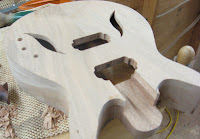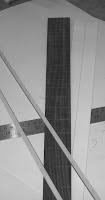


The same neck pocket preparation process is applied to The Rufus, except this guitar is to have a glued-in neck with a floating bridge which required an angled headstock. The rest of the process follows "Roy's Guitar, Chapter 16" Mike Snider (www.sniderguitars.com), a luthier and inlay artist was on hand to lend his expertise. Notice the care in wearing protective gloves during the guitar's procedure.






























